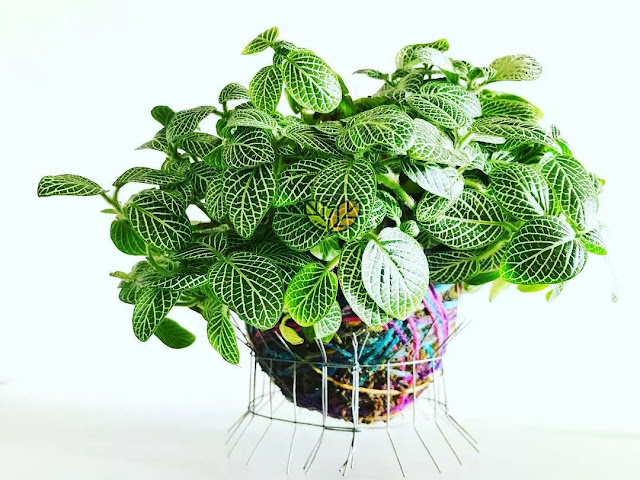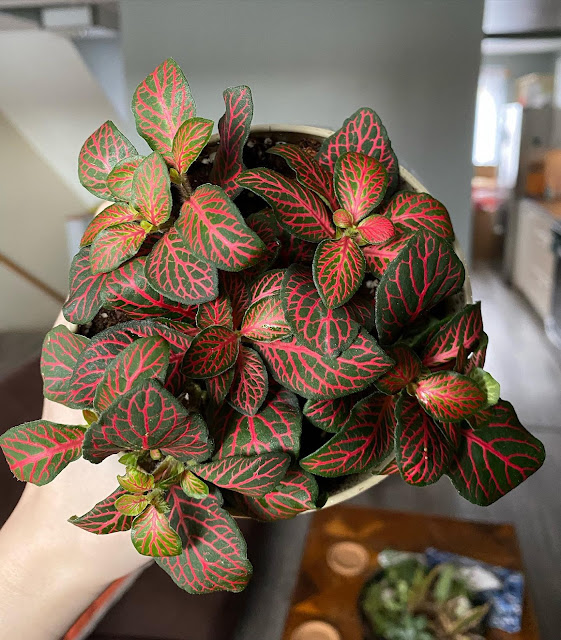Nerve Plant (Fittonia): That Thrives in Low Light
The nerve plant (Fittonia spp.) is a popular houseplant known for its delicately veined, deep-green, ovate leaves. It is slow-growing and typically grows to 3 to 6 inches with a trailing spread of 12 to 18 inches. Several nerve plants are available, with vein colors including silvery-white, red, pink, white, and green.
Nerve Plant Care:
Light:
As tropical plant, nerve plant prefers bright, indirect sun such as that offered by north-facing windows. It should not be exposed to full sunlight, which can cause leaf burn.
Soil:
Nerve plant grows well in standard potting soil with a peat moss base. The soil should be slightly acidic (pH 6.5) and retain some moisture while draining well.
Water:
Nerve plant requires constant moisture and is prone to collapse if it dries out. At the same time, it cannot tolerate stagnant water, which can lead to yellowed, limp leaves.
Temperature and Humidity:
Nerve plant thrives at temperatures around 70°F and prefers high humidity similar to that found in rainforests. Regular misting or using a room humidifier can help maintain the right conditions.
Fertilizer:
During its growing season, nerve plants should be fed weekly with a weak liquid fertilizer formulated for tropical plants. A balanced 5-5-5 fertilizer diluted to half strength is a good choice.
Pther Types of Nerve Plants:
Argyroneura: Deep-green leaves with silver-white veins
Pearcei: Deep-green leaves with reddish veins
Frankie: Light pink and green leaves
Fortissimo: Green foliage with red and pink veins
Red Star: Pink-red veined leaves
Pruning:
If a nerve plant's stems become leggy, pin the tips off to promote total, bushy growth. The plant's flowers are insignificant, so pinching off the buds can help keep the foliage full.
Propagation:
Nerve plants can be propagated from stem-tip cuttings in late spring or early summer. To reproduce, make a stem-tip cutting that includes at least two growing nodes, and plant in a pot filled with a peat-based soil mix. Keep the soil moist but not wet, and roots should sprout within two to three weeks.
Pests and Diseases
Fittonia plants are generally hardy and free from pests and diseases. However, if the conditions are not ideal, the plant may be susceptible to mealybugs, spider mites, and whiteflies. These pests can be easily treated with insecticidal soap or neem oil.
Fungal diseases such as root rot or stem rot may occur if the soil is too wet or the plant is stagnant. If you see signs of root rot, remove the plant from the pot and allow the soil to dry out completely. Cut away any infected roots and repot the plant in a fresh potting soil mix.
Nerve Plant Leaves Curling:
If the leaves of a nerve plant are curling, it could be a sign of several issues, such as improper watering, low humidity, or low light. If the plant is not getting enough water, the leaves may curl inward and become dry. If the humidity is too low, the leaves may also start to bow as a way to conserve moisture. The plant may try to reach for more light in common light conditions by curling its leaves.
Tips for Growing Nerve Plants
Provide high humidity by regularly misting the plant in a terrarium or near a humidifier.
Avoid direct sunlight and provide bright, indirect light.
Keep the soil consistently moist but not soggy.
Fertilize regularly during the growing season with a liquid fertilizer for tropical plants.
Prune periodically to keep the growth full and bushy.
Propagate from stem-tip cuttings in late spring or early summer.
Red Nerve Plant:
Silver Nerve Plant:
White Nerve Plant:
Nerve Plant Terrarium:
A nerve plant terrarium is a closed environment in which a nerve plant is grown. Terrariums can be made of glass or plastic and provide an ideal growing environment for nerve plants. The terrarium offers a warm, humid, shaded climate that helps the nerve plant thrive.
Red Veined Nerve Plant:
FAQs
What are nerve plants?
Nerve plants are tropical plants from the family of Gesneriaceae and are native to the rainforests of West Africa. They are named "nerve plants" because of their distinctive nerve-like patterns on their leaves.
What are the different types of nerve plants?
The most common nerve plant species are the red nerve plant (Fittonia aliveness), the silver nerve plant (Fittonia argyroneura), and the white nerve plant (Fittonia albo-lineata).
How do I care for nerve plants?
Nerve plants thrive in high humidity and moist soil. They prefer bright, indirect light and should be watered regularly but only sometimes to prevent root rot.
Can nerve plants be grown in a terrarium?
Yes, nerve plants can be grown in a terrarium. They are well-suited to this environment because they prefer high humidity and moist soil.
Why are the leaves of my nerve plant curling?
The leaves of a nerve plant may curl for various reasons, including too much direct sunlight, low humidity, or over-watering. Ensure that the plant receives the right amount of light and water, and maintain a humid environment to help prevent curling leaves.
What is a red-veined nerve plant?
The red-veined nerve plant is another name for the red nerve plant (Fittonia aliveness). It is named for its red veins on the leaves.
What is the best soil for nerve plants?
Nerve plants prefer well-draining soil with a slightly acidic pH between 5.5 and 6.5. A mixture of peat moss, perlite, and sand is a good option for growing nerve plants.

.webp)

.webp)





Comments
Post a Comment